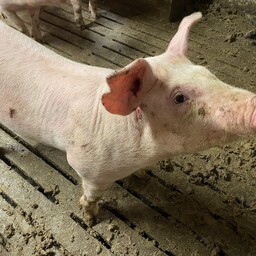Viljandi vallas, Nurme farmis leiti sigade haigus.
Haiguse tõttu hukatakse 4500 siga
. Sellest teatas põllumajandus- ja toiduamet (PTA).
Haiguse tõttu hukatakse 4500 siga
Tõlge fraasile: Haiguse tõttu hukatakse 4500 siga
EN
Due to the disease, 4,500 pigs will be culled
Laboratooriumi uuringud kinnitasid haiguse olemasolu
. Proov võeti tavapärase kontrolli ajal.
Kõik farmi sead hukatakse
, sest haigust ei saa ravida.
PTA korraldab farmi puhastuse ja desinfitseerimise
. Pärast seda saavad ruumid uuesti sigadele kasutada.
Laboratooriumi uuringud kinnitasid haiguse olemasolu
Tõlge fraasile: Laboratooriumi uuringud kinnitasid haiguse olemasolu
EN
Laboratory tests confirmed the presence of the disease
Kõik farmi sead hukatakse
Tõlge fraasile: Kõik farmi sead hukatakse
EN
All the pigs on the farm will be culled
PTA korraldab farmi puhastuse ja desinfitseerimise
Tõlge fraasile: PTA korraldab farmi puhastuse ja desinfitseerimise
EN
The Agricultural and Food Board (PTA) will organize the cleaning and disinfection of the farm
Farmis surnud või hukatud sigade eest saab taotleda rahalist hüvitist
. PTA hoiatab, et haigete loomade alale ei tohi minna ilma loata.
Ohutum käitumine aitab kaitsta Eesti seakasvatust
. Farmi lähedal võib liiklus olla keeruline.
Farmis surnud või hukatud sigade eest saab taotleda rahalist hüvitist
Tõlge fraasile: Farmis surnud või hukatud sigade eest saab taotleda rahalist hüvitist
EN
Financial compensation can be claimed for dead or culled pigs on the farm
Ohutum käitumine aitab kaitsta Eesti seakasvatust
Tõlge fraasile: Ohutum käitumine aitab kaitsta Eesti seakasvatust
EN
Safer behavior helps protect Estonian pig farming
Eelmine haiguse juhtum oli Raplamaal 25. juulil. Seal hukati 4000 siga. Sel aastal on haigestunud üle 17 000 seaga.
See haigus ei ole ohtlik inimestele ega teistele loomadele. Kuid inimesed võivad haigust levitada, kui nad puutuvad kokku haigete loomadega. Samuti võib haigust kandvaid asju olla autodel, riietel ja jalanõudel. Seetõttu tuleb need hoolikalt puhastada.
30. juuli seisuga on haigus leitud 67 metsseal. Haigus levis peamiselt suvel, juunist septembrini. See tähendab, suvel tuleb eriti hoolikalt jälgida sigade tervist. Kui kahtlus haiguse kohta tekib, tuleb kohe teavitada loomaarsti või PTA-d.
A swine disease was detected at Nurme farm in Viljandi municipality. Due to the disease, 4500 pigs will be culled. This was announced by the Agricultural and Food Board (PTA).
Laboratory tests confirmed the presence of the disease. The sample was taken during routine inspection. All pigs on the farm will be culled as the disease cannot be treated. PTA will organize cleaning and disinfection of the farm. After this, the premises can be used for pigs again.
Financial compensation can be claimed for pigs that died or were culled on the farm. PTA warns that entering areas with sick animals without permission is prohibited. Safer behavior helps protect Estonian pig farming. Traffic near the farm may be difficult.
The previous disease case was in Rapla County on July 25. There, 4000 pigs were culled. This year, over 17,000 pigs have been infected.
This disease is not dangerous to humans or other animals. However, people can spread the disease if they come into contact with sick animals. Items carrying the disease may also be present on cars, clothing, and footwear. Therefore, these should be carefully cleaned.
As of July 30, the disease has been found in 67 wild boars. The disease spread mainly in summer, from June to September. This means that in summer, pig health must be monitored especially carefully. If there is suspicion of the disease, a veterinarian or PTA should be notified immediately.

